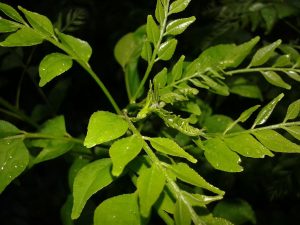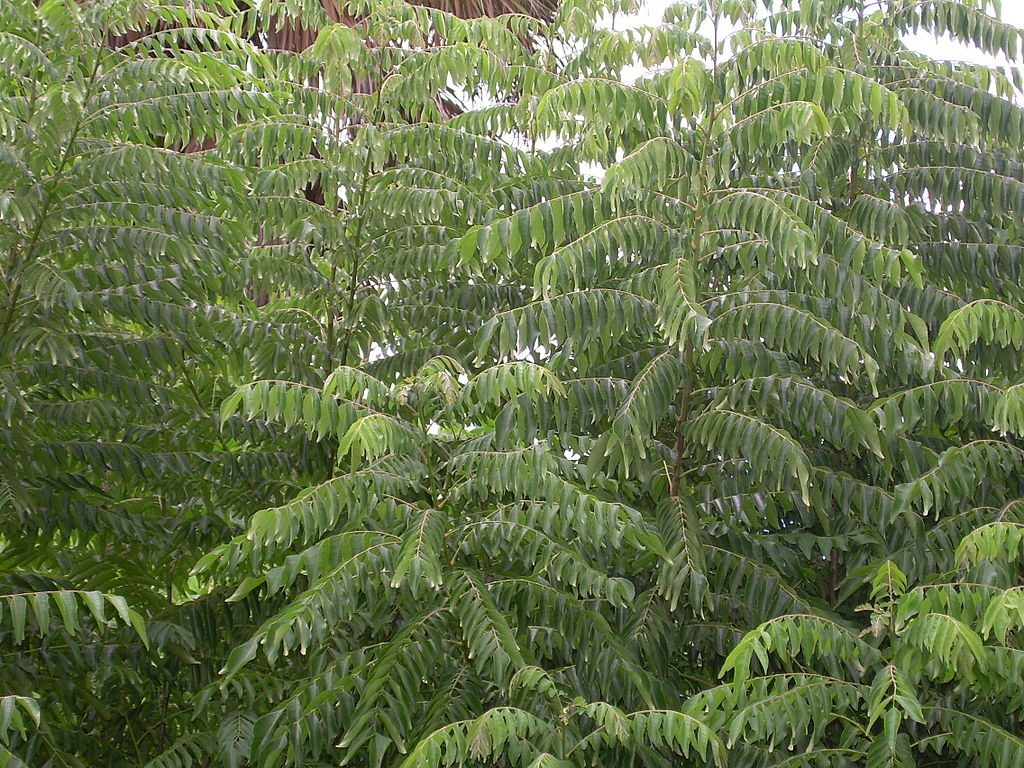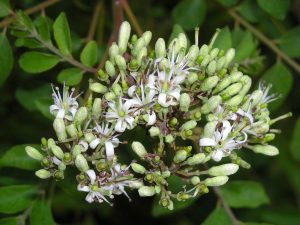Murraya koenigii (curry leaf) may bring blood sugar-balancing activity to weight loss formulas.

- Promoting anti-diabetic effects. Extracts of the herb have demonstrated a capacity to lower blood glucose and cholesterol levels in animal studies.
- Facilitating digestion. The high fiber content may enhance gastrointestinal function.
Overview
The small tropical curry tree (Murraya koenigii) is indigenous to India and Sri Lanka. It carries self-pollinating flowers that bear shiny black berries that are edible but rarely used for health or culinary purposes. Its aromatic leaves, on the other hand, have been incorporated into Southeast Asian foods as well as offered as a therapeutic agent in Ayurvedic medicine to combat illness and promote hair growth and overall well-being.
Health-promoting phytochemicals abound in curry leaves, some of which include the nutrients calcium and vitamin A, as well as proteins and dietary fibers. The leaves are also believed to contain minor quantities of vitamin B, iron, magnesium, and various essential oils. In traditional medicine, the primary health benefit of Murraya koenigii is a supposed anti-diabetic effect spurred by antioxidants such as alkaloids and polyphenols.
Early research has shown that the herb has promise in lowering blood glucose, cholesterol, and even body weight, which is why supplement users have begun promoting Murraya koenigii as a fat loss supplement.
The hypoglycemic effect of curry leaves makes it a great addition to porridges and similar meals for diabetics and people looking to maintain a low intake of fat and sugar.1

How Murraya Koenigii Might Help With Fat Loss
Anti-diabetic effects
Curry tree leaves have repeatedly shown potent anti-diabetic effects in animals — contributing to decreases in blood glucose, cholesterol, and triglyceride levels. Although their immediate purpose might not be to help people lose weight, these effects have been associated with overall fat loss, especially in diabetics. There are various proposed mechanisms driving these effects:
- Antioxidation. Decreasing levels of the oxidative stress marker malondialdehyde while increasing levels of the antioxidant glutathione seems to impart hypoglycemic and hypolipidemic effects.2 3
- Inducing paraoxonase 1. Extracts of these herbs are capable of boosting the activity of an enzyme known as paraoxonase 1, which possesses a capacity to lower lipid content.4
- Stimulating insulin synthesis. The herb seems to increase insulin synthesis and thus lower glucose levels in diabetic animals.5
Murraya Koenigii Benefits & Uses for Fat Loss

Though not clinical proven, early research suggests that Murraya koenigii may offer several other benefits related to fat loss: 6
- Facilitate body weight reduction
- Prevent obesity
- Improve digestion7
Research
Animal Research
Animal studies have consistently demonstrated the anti-diabetic, i.e., cholesterol and glucose lowering, effect of curry tree, but research concerning its ability to stimulate fat loss is conflicting.
Murraya koenigii may reduce body weight
In this controlled investigation, diabetic mice took injections of 80 mg of curry leaf extract per kg of bodyweight for 10 consecutive days. The extract led to statistically significant decreases in blood cholesterol and glucose levels compared to the control. The extract group also demonstrated a reduction in body weight.
- The researchers concluded that “curry leaf may be proved to be of clinical importance in improving the management of high cholesterol level and type 2 diabetes.”9
Murraya koenigii may help prevent obesity
In this investigation, obese rats took 300 mg of Murraya koenigii or mahanimbine extracts per kg of body weight every day for 2 weeks. The leaves resulted in significant reductions in body weight gain, cholesterol levels, and triglyceride levels.
- The researchers concluded that “extracts of Murraya koenigii leaves significantly reduced the body weight gain… [via] antiobesity and antihyperlipidemic activities.”10
Murraya koenigii may have anti-diabetic effects
In this controlled investigation, diabetic mice took either 100 or 200 mg of Murraya koenigii (ML) or Olea europaea (OL) leaves per kg of body weight. Compared to the control, there were significant decreases in cholesterol, triglyceride, and blood glucose levels, but no significant effect on body weight.
- The researchers concluded that “both the ML and OL possess a potent antihyperglycemic and hypolipidemic effect.”11
Murraya koenigii may help manage glucose, cholesterol, and triglyceride levels
In this controlled investigation, researchers daily gave 300 mg of a Murraya koenigii aqueous leaf extract per kg of body weight to normal and diabetic rats for 1 month. The extract group experienced a drop of 48.2% in blood glucose levels, 30.8% in total cholesterol levels, and 37.1% in triglyceride levels. The control group had similar but lower decreases.
- The researchers concluded that “the aqueous extract of Murraya koenigii has favorable effect in bringing down the severity of diabetes.”12
Human Research
There are no clinical studies related to Murraya koenigii for fat loss currently available.
Dosage for Fat Loss
- No clinical research studies have identified ideal dosage for fat loss.
- Supplemental doses are highly variable and range from daily servings of 970 mg of extract to 10 uncooked curry tree leaves.
Available Forms
- Capsules
- Liquid extract or tincture
- Natural (not dried or cooked) curry tree leaves
- Powder (Note: Murraya koenigii is available as curry leaf powder, which is markedly different from curry powder.)
Supplements in Review Says
- Murraya koenigii 1 g for Fat Loss.
M. koenigii may have anti-diabetic effects. Above all, the curry tree seems to be a powerful supplement for the management of diabetes, which has long been tied to excess glucose, cholesterol, and lipid levels. By countering the consequences of diabetes, the herb may also benefit fat loss. This process still needs to be verified in clinical trials.
Try 1 g of fresh curry tree leaves. Though Murraya koenigii is available as a capsule, powder, and tincture, it seems to be most potent when taken in its raw, non-dried, unprocessed form. A curry tree leaf offers roughly 0.1 g, which means about 10 leaves provides 1 g of substance.
Leave a Reply